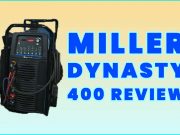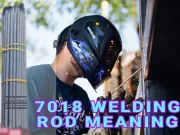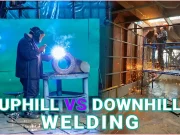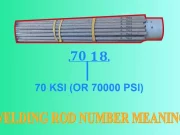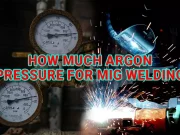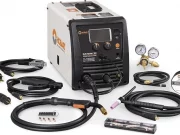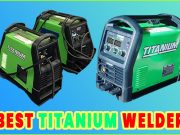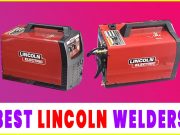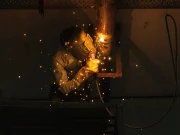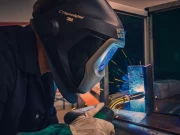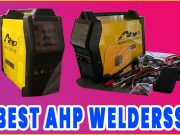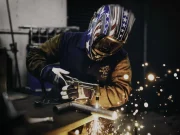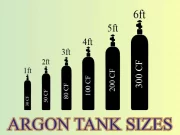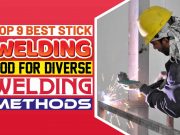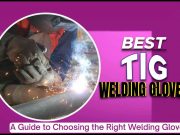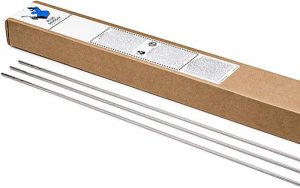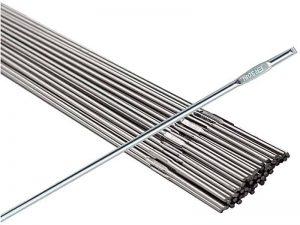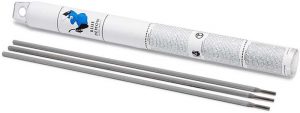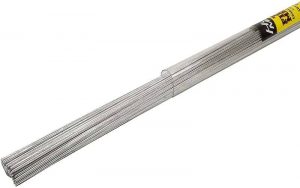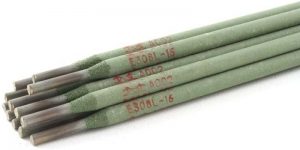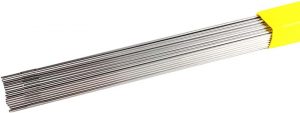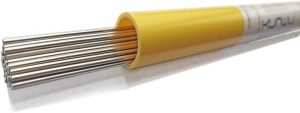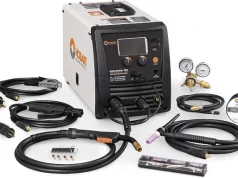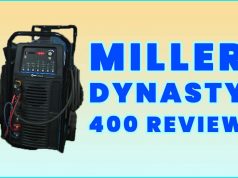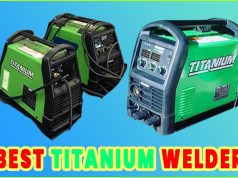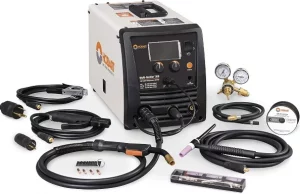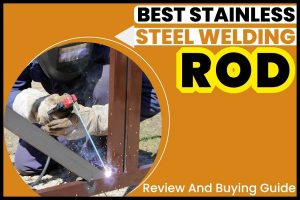
People indulge in welding for different reasons. You could be involved in welding for your home DIY repairs and remodelling, and you could be also involved in welding for commercial purposes. Regardless of your reasons for welding, you need to find the best stainless steel welding rod that will help you achieve great results, and reduce a wide range of problems associated with welding. Your welding rod is one of the most important components of welding, and you should pay careful attention when choosing it. Using the wrong rod for a different application can ruin your end product.
Our Top 3 Picks

The Top 3 Best Stainless Steel Welding - Rod
- Number of rods
- Tensile strengthMod et verteren usu.
- Emits lesser heatCurrent type
- Weight
- Length
- Welding position
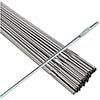
WeldingCity 1-Lb ER308L Stainless Steel 308 TIG Welding Rod
- 71
- 70000 PSI
- DC/AC
- 1 lb.
- 36 inches
- All
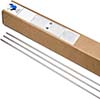
Blue Demon ER308L Stainless Steel TIG Welding - Rod
- 32
- 60000 PSI
- DC
- 1 lb.
- 36 inches
- Flat and horizontal
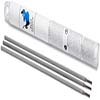
Blue Demon E308L , 1LB Tube stainless steel TIG welding Rod
- 32
- 60000 PSI
- AC/DC
- 0.5 lb.
- 36”
- Flat and horizontal
The Best Welding Rod For Stain Steel- A Review Of The Top 8
Are you looking for the best welding rod for stainless steel? Here is a list of some of the best-reviewed options to consider.
1. Blue Demon ER308L Stainless Steel TIG Welding Rod
This rod is a 10# style welding rod for welding varieties of steel effectively.
Specifications
- 0.03 x 36” measurements.
- Designed for types 321 and 347 stainless steel.
- It weighs 10.23 lbs.
- Size 0.03
- No batteries required.
- DCEP welding current.
- Welding positions F, V, OH, H.
- 32 rods in one package
Features
This is one welding rod designed for welding types 321 and 347 stainless steel types. The wire or rod is mainly suited for cryogenic temperatures; hence it is highly durable and highly convenient for the matched stainless steel.
It looks similar to the type 308 rod but comes with striking differences. The carbon content here is held to a maximum of 0.03% to prevent carbide precipitation. With 32 rods included, you have more than enough rods for welding stainless steel.
You may have to clean the rod now and then to achieve clean welding for stainless steel. Experts recommend that you clean this filler rod with a piece of fabric plus acetone before usage.
Pros
- It can handle cryogenic temperatures successfully.
- Designed to prevent carbide precipitation.
- It works with multiple welding positions.
- 32 rods included in a single pack.
- Cheaper than many competitors.
Cons
- It can be slightly magnetic.
2. WeldingCity 1-Lb ER308L Stainless Steel 308 TIG Welding Rod
This rod is a premium quality rod that works very well with TIG welding type and some other welding options.
Specifications
- 1/8” x 36”
- 1/16, 3/32, 1/8, and 0.045” diameters.
- Single end of rod stamped
- For cryogenic temperatures
- 100% Argon gas required
Features
More than ten sizes of these rods are available, in addition to the 1 lb. size. The rods come in diverse diameters, and that makes them suitable for different welding requirements. The package may also come in the 1lb, 5lbs, and 10 lbs. sizes; choose the one that suits your needs.
The chemical composition of the rod is 0.02% Carbon, 0.32% Silicone, 1.70% Manganese, 0.01% Phosphorous, 0.009 Sulphur, 20% chromium, and 10% Nickel. It also includes a substantial amount of Iron.
The minimal carbon content ensures the prevention of inter-granular carbide precipitation. It is excellent for general application and especially where corrosion is possible. It is most suited for steels in categories; 304, 304L, 308, 308L, 321, and 327.
Shielding gas is required for the application of these rods, and 100% Argon is preferred mostly.
Pros
- The single end of the rod is stamped.
- Several rods included.
- Less than 0.03% Carbon.
- Multiple steel version applications.
- It comes with a volume discount from the supplier.
Cons
- The rod is not coated.
3. Forney 44556 Stainless Steel Welding Rod
This rod is one weld rod with a very tiny thickness that works well with diverse welding material. It is available in different lengths and sizes too.
Specifications
- 3/32 inch thickness
- Ionized arc
- High tensile strength
- 16 rods included
Features
This 312-16 weld rod is considered the ultimate option for most stainless steel grades, especially those that work with any electrode stick for their power sources. It is also a welding rod that can be used by any welder regardless of their experience or level of practice.
The welding rod is completed with excellent tensile strength plus elongation for effective use for different welding projects. The arc has been ionized in such a way it cannot be short-out. It is mainly used for abrasion joining, corrosion-resistant, heated stainless steel, and horizontal fillet welds.
It is made of stainless alloy, which explains its high tensile strength that measures 128,000 PSI, and it is of high durability. It is 0.09 inches thick and also has 70 amperage capacity. It comes with a 90-day manufacturer guaranty.
Pros
- Very easy to use.
- It works with most steel grades.
- It can be used by all welders.
- Great tensile strength.
- Ionized arc to prevent shut-out.
Cons
- It is pretty pricey.
4. Blue Demon E308L Tube Stainless Steel Arc Welding Electrode
The Blue Demon brand is a reputable name in welding products, and this rod works excellent for all welders.
Specifications
- It measures 16 x 1/16” x 12”
- 1/16 inch size
- AC-DCEP welding current
- 1# tube style
Features
This is one welding rod you can use both AC and DC welding for. It works just fine for much stainless steel welding of different sizes. This rod comes with a tiny spark during usage and also has greater control.
With this rod, you wouldn’t have to worry about getting shielding gas, collets, filler rods, and tungsten, which are everyday items for TIG welding. You can even use this rod for your old stainless items such as charcoal grill without issues.
It has some aesthetic appeal and can be easily lightened up to start your welding. It would be best to be careful when using the rod because it can quickly burn through steel like the 12-gauge stainless steel. These rods may also flow a bit slower, but that shouldn’t be a problem for your welding.
Pros
- It offers greater control.
- No need for filler rods.
- It welds newer and older stainless steel well.
- Aesthetically appealing.
- Releases fewer flames.
Cons
- It is a little bit too short.
5. Hot Max 24189 1/16-Inch ER4043 Aluminium TIG Filler Rod
Hot Max may not be a very popular brand name but it offers competitive stainless steel rods for welding .
Specifications
- 1/16 inch thickness
- 36 inches in length.
- Contains 5% silicon
- It weighs 1 lb.
Features
These rods are built to improve fluidity on welding, hence they can be applicable for different welding materials aside steel.
The rod is designed to be applicable under cryogenic applications. This means it can withstand tremendous heat. You can also use it for welding stainless steel versions 304, 304L, 308, and 308L. With a carbon content of less than 0.03%, this welding rod is certified to be safe for the environment and the welder.
Less than 40 rods are included in this pack and that is a lot of rods for a long period of time.
Pros
Cons
6. E308L-16 – Stainless Steel Welding Electrode
This electrode for welding stainless steel appear slightly shorter than most of its competitors but still offer similar performance
Specification
- ½ lb. weight
- 1/8” size
- 14” length
- Austenite-ferrite joint application
- 80-90 Amps
Features
The versatile design of this stainless steel rod is one of its desirable features. It is designed to weld all kinds of stainless steel. It comes in 1/8” and 3/32” thicknesses, and these two versions are available in weights of 0.5 lb., 2 lbs., and 4.4 lbs.
This rod can be welded in just any position except the vertical-down option. It applies to the austenite-ferrite standard procedure. Every pack of this product comes with the material certification alongside a manufacturer guaranty.
The product operates on 80-90 amperage of electricity. It contains less than 0.03% carbon, which makes it safer for the welder and the environment.
This rod comes with a self-removing slag plus a very low spatter tendency feature. It is excellent for cladding and working on all sorts of corrosion-resistant layers and non-alloyed construction steels. You can also use it for buffer layers.
Pros
- It works with various stainless steel.
- Versatile for different welding positions
- Easy-burning rods.
- Easy-to-control.
- self-removing slag.
Cons
- It can be difficult for beginners to strike an arc.
7. ER308L – TIG Stainless Steel Rod, 5Lbs
This is a unique stainless steel welding rod with more significant weight for welding thicker stainless steel materials.
Specifications
- 1/8” thickness
- 36” length
- 5 lbs. weight.
- Shielded gas like 100% Argon needed
- 1 lb. to 11 lbs. packages, available.
- Available diameters from 0.03 to 3/16”.
Features
It is designed to weld austenitic stainless steels such as those containing 19% Chromium and 9% Nickel; these include the 321 and 347 stainless steel sheets.
With less than 0.03% content, this rod protects the welded deposits and zones; hence, it can yield X-ray quality welds.
Some of the most standard applications of this rod are; stainless steel fabrication of food equipment such as those used in dairy, restaurant, and chemical tanks. These are places where corrosion concerns are of moderate concern.
The recommended TIG welding parameters for these welding rods are; DCEN DC, Argon, or helium shielded gas use and Tungsten parameters of 2% each for Thoriated and Created component. Available in various diameters for versatile usage.
Pros
- Produce more outstanding quality welds
- Multiple applications.
- Ideal for use in cryogenic temperatures.
- Higher penetration recorded with shielded gas usage.
- Higher speeds of welding.
Cons
- May not come in a tube as shown.
8. KUNWU Stainless Steel TIG Welding Rods ER308L
This is one of the best welding rods from the manufacturer and offers a great deal just like the mire popular brands
Specifications
- 5 lbs. weight
- 36” length
- 1/16” size
- 0.03 carbon component
- Packed in PVC tube.
Features
It is used in welding austenitic steels like the 304L, 308L, 321, and 347. It comes with a very low carbon content of less than 0.03% and that increases welded metal’s resistance to corrosion.
It can be used in welding everyday components like kitchen and furnace appliances. It can also be used for welding restaurant equipment, chemical plants and for general applications. It is most suitable in situations where issues of corrosion are of moderate concern.
Pros
- It can be used to weld many steel types.
- Increases resistance to corrosion.
- It comes with manufacturer warranty.
- Highly resistant to moisture.
- Affordable.
Cons
- It can be too thin for some applications.
Choosing The Right Stainless Steel Welding Rod
There are certain things you must watch out for when choosing the best stainless steel welding rod. According to expert welders, the following are the factors you must consider before choosing the right stainless steel welding rod for any welding project;
- Base metal properties
- Tensile strength
- Welding current
- Thickness and shape
- welding position
- Specs and service conditions
- Welding environmental conditions
The base metal properties are the first things you should watch for when choosing your stainless steel welding rod. You should match your rod with the ideal base metal. In this case, you are using a stainless steel welding that will only match stainless steel base metal. If the base or metal you are welding is magnetic, the best rod will be stainless steel or carbon steep.
You must also know what type of spark the metal gives when touched by the grinder. More flare and sparks mean more carbon components of the rod; hence you should not go for such.
The tensile strength of the rod is another feature you must consider. To prevent issues such as cracking and weld discontinuities, you should match the tensile strength of your stainless steel rod with your weld metal.
You can detect the tensile strength of your stainless steel rod by checking the first two digits of its AWS classification that is printed on the side of the rod. For instance, an E7011 label on the stainless steel rod means the rod can produce a minimum tensile strength of 70,000 PSI. This tensile strength will work perfectly with a welded metal of similar tensile strength. Don’t choose a stainless steel welding rod of lower tensile strength for metal with higher tensile strength, and it can mess up your welding job if you do.
The welding current also matters. While some stainless steel welding rods can work for both AC and DC, others can only work with either of the two. To determine the right current type for your stainless steel welding rod, simply check the fourth digit of the AWS classification – this represents the coating type and electricity type the rod uses.
Take note that the type of electricity a stainless steel rod uses determines the penetration level of the weld. The DCEP current type, for instance, provides deeper penetration and produces a tighter arc than the DCEN, which only makes mild penetration. AC is generally used in welding clean and newer metals, while DC will provide deeper penetration for rough and older metals.
The weld metal or base metal thickness is also important when choosing the right stainless steel rod for welding. Thick welded materials will naturally require the utmost ductility plus lower hydrogen to prevent your weld from cracking. This is why stainless steel rods ending with AWS numbers 15, 16, 17, and 18 do have much lower hydrogen levels and good toughness for higher impact and are more able to handle more residual stress.
For thinner metals, you will need a stainless steel rod that can produce softer arcs. Similarly, rods with smaller diameters will make shallower penetration to prevent a burn-through effect on thinner metals.
The welding position of your stainless steel welding rod is as important as any other factor when making your final choice. To ascertain the appropriate welding position of the rod, simply check the third digit of the AWS specification. If the number is 1, the welding position is flat, horizontal, vertical, and overhead. If the number is 2, the welding positions are; flat and horizontal only. For this reason, you may want to opt for number 1 if you prefer multiple welding positions for the rod.
The specification service conditions of a welding rod are also necessary. You must be sure whether You can use the rod in high heat or low-temperature environments. You must be sure if the rod will or will not be exposed to repetitive shock loading. For instance, a low-hydrogen rod with higher ductility will likely reduce the chances of weld cracking.
Also, check for welding specifications, especially when working on critical jobs like boiler applications and pressure vessels. Certain applications will require that you use specific welding rods.
When choosing a stainless steel electrode or rod, you must consider several environmental conditions. To achieve the best results with your welding, you must eliminate excess mill scales, alongside moisture, mist, paints, grease, and rusts from metal surfaces before welding.
Cleaning the base metal or welded metal will help reduce the risks of porosity. It will also increase travel speeds. If cleaning the metal is impossible, you should go for rods that produce a more profound penetrating arc because they can cut through any contaminant.
Considering the factors above will help determine the right stainless steel welding rod for your welding project. With the wide range of available stainless steel rods, you may have several solutions for any welding issue. Fortunately, most welding rod manufacturers offer online support that you can also get from local welding product distributors.
Price should be your last consideration as you need to have a budget for purchasing a welding rod.
How do I Match My Welding Rod With The Right Weld Base?
As mentioned earlier, the first step you should take is to match your rod with the properties of the base metal, which is the material you want to weld. Make sure you compare the tensile strength of both the rod and metal; for mild steel, for instance, the E60 and E70 should work fine.
The second step is to match the rod type to the welding position it works with. Check the power that was recommended. Check the joint design before choosing the rod that will provide the best penetration you want. For instance, joint characteristics may require different rods for digging, medium or light penetration.
E6010 and E6011, for example, will provide some digging arcs that can penetrate deeper when working on tight fit-up that will create sufficient penetration. For thinner materials or those with joints that have wider root openings, the E6013 with soft arc may be the best rod for welding.
If you want to avoid cracking on thick and heavy material, especially on complicated joint designs, choose a rod with maximum ductility. For extremely low or high-temperature welding or welding in a shock-loading environment, the E7018 may be the best for such situations because it comes with low hydrogen.
Suppose you are looking for a rod that offers greater production efficiency, especially when working in a flat position. In that case, you should go for the E7014 or E7024 because of their higher deposition rates. You must always check the welding procedures and requirements for different applications.
Frequently Asked Questions (FAQs) About Welding Rods
Whether you are a regular DIY welder or you use welding electrodes few times a year, one thing is for sure, and rod welding requires some knowledge and welding skills. The following questions are the most frequently asked, especially about welding rods in general.
Question: What are the commonest welding rods?
Answer: Hundreds of welding rods exist, but the commonest ones are categorized according to the AWS (American Welding Society), which is the organization that classifies the carbon steel electrodes sold in commercial markets. The commonest welding rods are; E6010, E6011, E6012, E6013, E7014, E7018, and E7024.
Question: What does the AWS electrode classification mean?
Answer: To help in identifying welding rods, the standard classification system of the AWS is applicable. These classifications are numbers and letters printed on the sides of the rods. Each number and letter represent specific characteristics of the rod.
The letter E, for instance, indicates an electrode or rod. The first two digits or numbers represent the rod’s minimum tensile strength measured in PSI (Pounds per square inch). For instance, in the E6010, the electrode will produce a weld bead with a minimum tensile strength of 60000 PSI.
The third digit on the classification represents the welding position for which you can use the rod. For instance, in E6010, the number 1 means the rod can be used for welding in all positions, while the number 2 means you can only use the rod in the flat and horizontal positions.
The fourth digit of the classification represents the coating type and current type that works with the rod. This classification could mean AC or DC or both.
Question: What are the differences between the commonest Stainless steel Rod Categories?
Answer: The commonest stain steel rod categories are; E6010, E6011, E6012, E6013, E7014, E7018, and E7024.
The E6010 can be used with the DC and not AC. They can penetrate deep even through rusts, paint, oil, and dirt on metal surfaces. You can use them for welding in all positions, and they form a very tight arc. The issue here is that they can be difficult for beginner welders to use.
You can also use the E6011 rods for all-position welding. It works only with an AC power source. They also produce a deep and penetrating arc that can cut through rusty metals. Most welders choose this option because of the maintenance and repair jobs, especially when the DC rod-like E6010 is unavailable.
The E6012 welding rod works very well for applications requiring gap-bridging between two joints. Many professional welders prefer the E6012 because of its high speed alongside high current fillet welds in a horizontal position. The issue with these electrodes or rods is that they produce shallower penetration that may require some cleaning after welding.
The E6013 welding rods will generate a softer arc with minimal spatter, especially after moderate penetration. It is also preferred because it comes with an easy-to-remove slag. It would be best to use these rods only on clean weld metals such as new sheet stainless steel.
The E7014 produces similar penetration to the E6012. They are recommended for use on only carbon and low-alloy steel. These rods come with a high amount of iron powder, increasing rates of deposition after welding. These rods require higher amperage when compared to the E6012.
The E7018 rods come with thick flux with some higher Iron powder content. These rods are some of the easiest you can use, hence it is preferred by many beginner welders. These rods generate a smoother and quieter arc with much less spatter plus a medium penetration effect.
Many welders also prefer these rods when welding thicker metals like structural steel. The rods can produce strong welds with high impact properties, especially in cold weather. The rods can be applied to carbon steel and high-strength steel metals.
The E7024 contains a very high amount of Iron powder, leading to a higher residue deposition rate. These rods are great for high speed and horizontal, and flat welding positions. The rods can perform great on a steel plate of at least ¼” thickness; hence they are great for thicker metals.
Question: What is the best way to dry and store welding rods for stainless steel?
Answer: The best way to store your welding rod for stainless steel is to pack them in their storage pack and keep them in a low humidity environment. If possible, the storage environment should be slightly heated.
For instance, some mild steel, like the E7018 rod with low hydrogen, must be stored at temperatures of between 250 and 300F degrees. Raising temperatures at storage for these rods can help remove excess moisture before and after usage.
Some welding rods like the E6010 and E6011 will only require storage at room temperatures, though the rod may prefer a dryer environment. When stored at room temperatures, the humidity of the environment must not be higher than 70%, and temperatures should be between 40 and 120F degrees.
Conclusion
With the product reviews and buying guide above, you should find the best stainless steel welding rod. Since the best rod for one person dealing with a particular application may be different from yours, you should focus on your requirements regarding the application you are handling before making your final choice. Fortunately, welding rods for stainless steel come in a pack of many rods with different diameters but the same length. It would be best to use other rods for different occasions according to the thickness of base metal and tensile strength required. Always consult the user manual for details.

